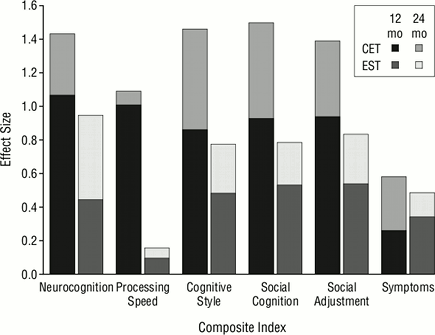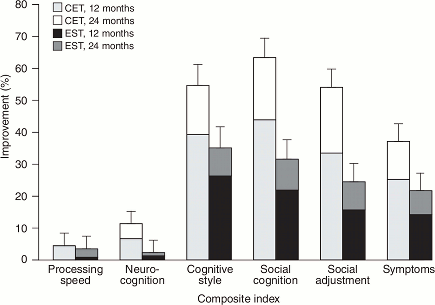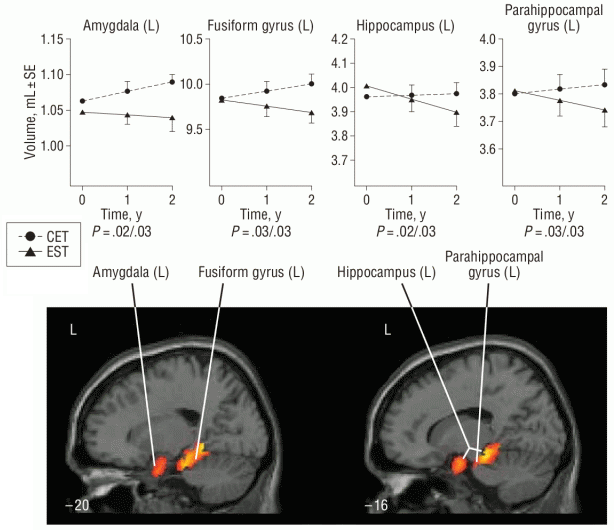EVIDENCE SUPPORTING THE EFFECTIVENESS OF CET
Cognitive Enhancement Therapy (CET) is an evidence-based practice that was developed by the late Professor Gerard E. Hogarty, M.S.W. at the Department of Psychiatry, University of Pittsburgh School of Medicine. This intervention is designed for individuals with schizophrenia who are in the recovery phase of the condition (stabilized on medication, outpatient, IQ greater than 80, not abusing drugs and alcohol).
The first study of CET was completed in 2004 by Hogarty and colleagues with 121 persons with schizophrenia or schizoaffective disorder treated with either CET or Enriched Supportive Therapy (EST). As can be seen in Figure 1, patients receiving CET demonstrated significant and large improvements across the domains of Neurocognition, Processing Speed, Cognitive Style, and Social Cognition, after two years of treatment. Symptom effects were assessed, but not expected, since the eligibility criteria for study participation included symptom stabilization with antipsychotic medication.
Comparative Benefits of CET vs. EST – Study 1
(Chronic Schizophrenia, N = 121)

Figure 1
Most importantly, not only did Neurocognition and higher-order Social Cognition improve, but individuals who received CET also demonstrated significant functional improvements, particularly in the area of Social Adjustment, which included social and major role functioning, instrumental task performance, and work readiness.
Comparative Benefits of CET vs. EST – Study 2
(Early Schizophrenia, N = 58)

Figure 2
The second study of CET was completed in 2009 by Professor Hogarty, Dr. Matcheri S. Keshavan, and Dr. Shaun M. Eack with 58 individuals in the early course of schizophrenia or schizoaffective disorder treated with either CET or Enriched Supportive Therapy (EST). As can be seen in Figure 2, CET again proved to be highly effective for improving social and non-social cognitive deficits in the disorder. Neurocognitive and Processing Speed improvement was not as marked in this early course sample, most likely due to the greater pre-treatment ability of this younger population. However, there were substantial CET effects on Social Cognition and Social Adjustment. By the end of two years of treatment, very disabled early course patients treated with CET demonstrated significant improvements in social functioning, employment, major role functioning, work readiness, activities of daily living, and instrumental task performance.
Neuroprotective Effect of CET Against Gray Matter Loss in Early Course Schizophrenia (N = 53)

Figure 3
In addition to collecting data on the effects of CET on cognitive and behavioral outcomes in early course patients with schizophrenia, we have also assessed these patients using structural MRI. Figure 3 shows areas of the brain with significant differential changes in gray matter between CET and EST patients. As has been frequently reported by other groups, schizophrenia patients typically show a loss of gray matter on MRI. Consistent with this finding, patients treated with EST demonstrated a progressive loss of gray matter in left medial-temporal regions associated with neurocognitive and social-cognitive impairment (i.e., amygdala, hippocampus, parahippocampal gyrus, and fusiform gyrus). In contrast, CET patients demonstrated significant differential maintenance of gray matter volume in these regions, including some growth in left amygdala volume. A further analysis indicated that the neuroprotective advantage of CET against gray matter loss in these areas mediated the robust 2-year effects of CET on social cognition and neurocognition.
Most encouraging, both chronic and early course studies (Hogarty, Greenwald, and Eack, Psychiatric Services, 2006;57:1751-1757; Eack et al., Schizophrenia Research, 2010;120:210-216) have shown CET effects to persist for at least an additional year following treatment. For a complete bibliography on CET and new scientific developments surrounding its use in schizophrenia, adult autism spectrum disorder, and other conditions see the CET Bibliography.